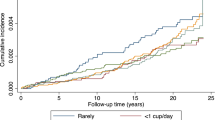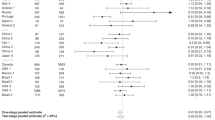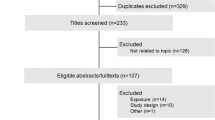Abstract
In a prospective study of 19 561 Japanese men, green-tea intake was not associated with a lower risk of prostate cancer (110 cases), the multivariate hazard ratio for men drinking ⩾5 cups compared with <1 cup per day being 0.85 (95% confidence interval 0.50–1.43, trend P=0.81).
Similar content being viewed by others
Main
Although laboratory studies have suggested a protective effect of green-tea polyphenols against development of prostate cancer in animal models (Gupta et al, 1999; Saleem et al, 2003), few epidemiological studies have examined the association. A case–control study in China found that green-tea intake was associated with a lower risk of prostate cancer (Jian et al, 2004), whereas a prospective study of Japanese Americans in Hawaii and a case–control study in Japan found no such association (Severson et al, 1989; Sonoda et al, 2004). The age-standardised incidence of prostate cancer is low in Japan (12.7 per 100 000), being approximately one-tenth of that in the US (Parkin, 2002). Green-tea consumption per capita in Japan is the highest in the world (International Tea Committee, 2004). One reason for the low incidence of prostate cancer in Japan may be the high consumption of green tea. We therefore examined the association between green-tea consumption and prostate cancer incidence among men in the Ohsaki Cohort Study conducted in rural Japan.
Materials and methods
The details of the Ohsaki Cohort Study have been described previously (Tsuji et al, 1999; Anzai et al, 2005). Briefly, this prospective cohort study was started in 1994 and included 26 481 men aged 40–79 years living in 14 municipalities of Miyagi Prefecture (95% response rate) (Anzai et al, 2005). The study used a self-administered questionnaire that included items about the frequency of consumption of beverages (coffee, green tea, black tea) and food items, as well as alcohol drinking, smoking and other health-related lifestyle factors. We asked the subjects about their frequency of green-tea consumption according to five categories: never, occasionally, 1–2 cups per day, 3–4 cups per day and 5 or more cups per day. The validity of green-tea consumption was assessed by calculating Spearman correlation coefficients between the 12-day dietary records and the 40-item food-frequency questionnaire. The age- and energy-adjusted Spearman correlation coefficient in men was 0.71 (Ogawa et al, 2003). After exclusion of subjects with missing responses or with a prior history of cancer, 19 561 subjects remained. We followed up the vital and residential status of the subjects using population registries from 1 January 1995 to 31 December 2001. Reference to population-based cancer registries identified 110 incident cases of prostate cancer (7 years of follow-up with 121 543 person-years). During the study period, there was no mass screening programme for prostate cancer in this area.
We combined the lower two categories of green-tea consumption into the single category ‘less than one cup per day’ because of the small number of subjects in each category. We estimated hazard ratios (HRs) and the 95% confidence interval (CI) of prostate cancer incidence according to green-tea consumption, using the Cox proportional hazards model with adjustment for age and potential confounders. P-values for the test of linear trend were calculated by treating the green-tea consumption category as an ordinal variable. All P-values were two-tailed. This study had approximately 80% statistical power, with a two-sided α-error level of 5%, in detecting a true HR of 0.75 among the highest vs lowest categories of green-tea consumption.
Results
Table 1 shows the characteristics of the subjects according to green-tea consumption. Subjects with a higher green-tea intake tended to be older, to have a higher calorie intake, to consume calcium and fish more frequently, and to drink coffee less frequently.
We found no significant association between green-tea consumption and the risk of prostate cancer. Multivariate HRs for prostate cancer associated with drinking 1–2, 3–4 and 5 or more cups of green-tea per day, as compared with less than one cup per day, were 0.77 (95% CI 0.42–1.40), 1.15 (0.69–1.94), and 0.85 (0.50–1.43), respectively (trend P=0.81) (Table 2). Exclusion of prostate cancer cases diagnosed in the first 3 years of follow-up did not substantially change the results.
When the data were stratified according to age, smoking, alcohol drinking, body mass index, frequencies of meat and fish consumption, and frequencies of coffee and black tea consumption, there was no association between green-tea consumption and the risk of prostate cancer.
We also examined the relationship between consumption of black tea or coffee and the risk of prostate cancer. The multivariate HRs (95% CI) compared with men who never drank black tea were 1.34 (0.77–2.34) for those drinking black tea occasionally and 0.60 (0.13–2.68) for those drinking one or more cups per day (trend P=0.78). The corresponding HRs for coffee were 0.60 (0.35–1.05) and 0.67 (0.38–1.19) (trend P=0.27). Our results were consistent with the judgment of the World Cancer Research Fund that consumption of black tea or coffee has no relationship with the risk of prostate cancer (World Cancer Research Fund, 1997).
Discussion
This is the first prospective cohort study of green-tea consumption and prostate cancer incidence in Japan. We found no association between green-tea consumption and prostate cancer incidence among Japanese men, who consume green tea much more frequently than men in Western countries. Our results conflicted with those of a case–control study in China (Jian et al, 2004), but agreed with those of a prospective study in Hawaii and a case–control study in Japan showing no association between green-tea consumption and prostate cancer incidence (Severson et al, 1989; Sonoda et al, 2004).
Our study had several methodologic advantages over previous studies of the subject. We recruited subjects from the general population, and there was a large variation in green-tea consumption among our subjects. In addition, we assessed the consumption of green-tea and other variables before cases of prostate cancer were diagnosed, thus avoiding recall bias. The questionnaire used to measure green-tea consumption had a reasonably high level of validity and reproducibility.
As a potential limitation of the study, we could not specifically examine the effect of very high consumption of green tea because the highest category in our questionnaire was five or more cups per day. However, the validation study of our food frequency questionnaire found that 53% of the subjects who reported consuming five or more cups per day actually consumed seven or more cups per day according to 12-day diet records (Ogawa et al, 2003). It is therefore unlikely that we failed to detect a decreased risk of prostate cancer among the subjects consuming very large amounts of green tea.
In conclusion, this prospective cohort study conducted in rural Japan showed no association between consumption of green tea, coffee or black tea and the risk of prostate cancer.
Change history
16 November 2011
This paper was modified 12 months after initial publication to switch to Creative Commons licence terms, as noted at publication
References
Anzai Y, Kuriyama S, Nishino Y, Takahashi K, Ohkubo T, Ohmori K, Tsubono Y, Tsuji I (2005) Impact of alcohol consumption upon medical care utilization and costs in men: 4-year observation of National Health Insurance beneficiaries in Japan. Addiction 100: 19–27
Gupta S, Ahmad N, Mukhtar H (1999) Prostate cancer chemoprevention by green tea. Semin Urol Oncol 17: 70–76
International Tea Committee (2004) Annual Bulletin of Statistics. London: International Tea Committee
Jian L, Xie LP, Lee AH, Binns CW (2004) Protective effect of green tea against prostate cancer: a case-control study in southeast China. Int J Cancer 108: 130–135
Ogawa K, Tsubono Y, Nishino Y, Watanabe Y, Ohkubo T, Watanabe T, Nakatsuka H, Takahashi N, Kawamura M, Tsuji I, Hisamichi S (2003) Validation of a food-frequency questionnaire for cohort studies in rural Japan. Public Health Nutr 6: 147–157
Parkin D (2002) Cancer Incidence in Five Continents, Vol. 8, Lyon: International Agency for Research on Cancer
Saleem M, Adhami VM, Siddiqui IA, Mukhtar H (2003) Tea beverage in chemoprevention of prostate cancer: a mini-review. Nutr Cancer 47: 13–23
Severson RK, Nomura AM, Grove JS, Stemmermann GN (1989) A prospective study of demographics, diet, and prostate cancer among men of Japanese ancestry in Hawaii. Cancer Res 49: 1857–1860
Sonoda T, Nagata Y, Mori M, Miyanaga N, Takashima N, Okumura K, Goto K, Naito S, Fujimoto K, Hirao Y, Takahashi A, Tsukamoto T, Fujioka T, Akaza H (2004) A case–control study of diet and prostate cancer in Japan: possible protective effect of traditional Japanese diet. Cancer Sci 95: 238–242
Tsuji I, Kuwahara A, Nishino Y, Ohkubo T, Sasaki A, Hisamichi S (1999) Medical cost for disability: a longitudinal observation of national health insurance beneficiaries in Japan. J Am Geriatr Soc 47: 470–476
World Cancer Research Fund (1997) Coffee, tea, and other drinks. In Food, Nutrition and The Prevention of Cancer, A Global Perspective pp 467–471. Washington, DC: American Institute for Cancer Research
Acknowledgements
This study was supported in part by a grant-in-aid of Third Term Comprehensive Control Research for Cancer from the Ministry of Health, Labour and Welfare, Japan (H16-3ji-gan-010).
Author information
Authors and Affiliations
Corresponding author
Rights and permissions
From twelve months after its original publication, this work is licensed under the Creative Commons Attribution-NonCommercial-Share Alike 3.0 Unported License. To view a copy of this license, visit http://creativecommons.org/licenses/by-nc-sa/3.0/
About this article
Cite this article
Kikuchi, N., Ohmori, K., Shimazu, T. et al. No association between green tea and prostate cancer risk in Japanese men: the Ohsaki Cohort Study. Br J Cancer 95, 371–373 (2006). https://doi.org/10.1038/sj.bjc.6603230
Received:
Revised:
Accepted:
Published:
Issue Date:
DOI: https://doi.org/10.1038/sj.bjc.6603230
Keywords
This article is cited by
-
Reduced prostate cancer risk with green tea and epigallocatechin 3-gallate intake among Hong Kong Chinese men
Prostate Cancer and Prostatic Diseases (2017)
-
Tea consumption and the risk of five major cancers: a dose–response meta-analysis of prospective studies
BMC Cancer (2014)
-
Tea consumption and prostate cancer: an updated meta-analysis
World Journal of Surgical Oncology (2014)
-
Recent progress on nutraceutical research in prostate cancer
Cancer and Metastasis Reviews (2014)
-
Green and black tea intake in relation to prostate cancer risk among Singapore Chinese
Cancer Causes & Control (2012)



